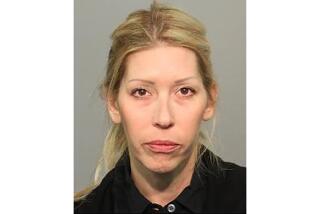Issue Guidelines on Holiday Safety : Schools Tell Teens How to Toe the Party Line
- Share via
It boils down to a case of meddling, pure and simple, said Amy, a 10th-grader at Crossroads School in Santa Monica.
“It’s just not fair,” she snapped. “They can tell me what to do when I’m in school, but on the weekends when I am on my own time, it is none of their business.”
Amy’s reaction was typical among the hundreds of students on the Westside and in the San Fernando Valley whose parents were mailed guidelines by school officials on party-going for young people.
“We know that most parents supervise their children’s parties, but unfortunately some do not,” said Paul F. Cummins, headmaster of Crossroads. “We have no idea what impact the letter will have, but if it saves one life, it is worth it.”
The list includes 16 guidelines, ranging from the suggestion that an adult be present at parties for teen-agers to the admonition that anyone under the age of 21 not be served an alcoholic beverage.
And if someone is suspected of having had one drink too many, the guidelines say, he should not be allowed to drive. The guidelines also suggest that parents know where the party is and who is giving it.
The letter was first distributed at an East Coast prep school and has been sent to students at 10 private and one public high school on the Westside and in the San Fernando Valley.
In addition to Crossroads, the guidelines were sent to parents of students at Oakwood School, Buckley School, Windward School, Loyola High School, Harvard School, Marlborough School, Westlake School, Campbell Hall School and Brentwood School.
Santa Monica High School Principal W. Terry Pearson sent a similar letter to parents of his students, making a case for tighter controls on parties for teen-agers.
Difficult Judgments
“It is extremely difficult for adults to monitor adequately a large party,” he wrote. “It is even more difficult to judge who is or is not capable of driving; adolescent drivers with one or two beers get in accidents as often as those who are drunk.”
In addition to routine counseling about problems associated with drug and alcohol abuse, Santa Monica High School students also take part in a safe-ride program that provides intoxicated teen-agers with a free ride home--no questions asked.
An increased awareness about the problems of teen-age drinking and driving has been cited as a reason for a decline in auto fatalities. According to the National Highway Safety Administration, the number of traffic fatalities involving teen-agers (ages 15 to 19) driving under the influence of alcohol has declined over the last five years from 4,135 in 1982 to 3,540 in 1986.
Rena McKinzie, president of the Santa Monica High School’s PTSA, said that parents need to understand that they are not alone when it comes to restricting their youngsters.
“Sometimes children give you the argument that ‘everyone else is doing something (drinking), so why can’t I?’ The problem is everyone else is not doing it and parents need to know that there are standards,” she said.
When the letters were mailed, Nathan O. Reynolds, the headmaster of Westlake, recalled one bitter reaction from a student who said she was offended.
“Ironically, that Saturday night a friend of hers from another high school was killed in an auto accident,” Reynolds said. “She came in the next week and said she understood why the guidelines were important. It brought home the point we were trying to make.”
GUIDELINES FOR GIVING A PARTY
1. A parent should be at home and visible during the party. Parents can greet guests, bring in snacks and non-alcoholic beverages. Invite other parents to help if your party is large.
2. Do not offer alcohol to guests under the age of 21 or allow guests to use drugs in your home. You may be brought to court on criminal charges and/or have to pay monetary damages in a civil law suit if you furnish alcohol or drugs to minors.
3. Guests who try to bring in alcohol or drugs or who otherwise refuse to cooperate with your expectations should be asked to leave. 4. Do not let anyone drive under the influence of alcohol or drugs. 5. Let your teen-ager know what you expect. In setting ground rules with your teen before an event, you will both have an opportunity to express feelings.
6. Plan to have plenty of food and non-alcoholic drinks on hand.
7. Plan the party with your teen-ager before the event. Plans should include such things as time limits, number of guests, type of music.
8. Do not allow any guest who leaves the party to return. This will discourage teen-agers from leaving the party to drink or use drugs elsewhere and then return to the party.
9. Avoid open-house parties. Know who is expected to attend. It is important to discourage crashers.
10. Consider notifying your neighbors that there will be a party.
GUIDELINES FOR ATTENDING A PARTY
1. Know where your teen-ager will be. Obtain the address and telephone number of the party-giver. Let your teen-ager know that you expect a telephone call if the location of the party is changed.
2. Contact the parents of the giver to verify the occasion. Be sure that a parent will be present. Be sure that alcohol and other drugs will not be permitted.
3. Be certain your teen-ager knows when he or she is supposed to be home.
4. Know how your teen-ager will get to and from the party. Assure your teen-ager that you or a specific friend or neighbor can be called for a ride home (make sure your teen has the telephone number). Discuss with your teen-ager the possible situations in which the teen might need to make such a call.
5. If your teen-ager stays overnight with a friend after a party, check with the parents of the friend beforehand to verify that: They know your teen is staying over. They will be home. You both agree on curfew hours and rules.
6. Be awake or have your teen-ager awaken you when he or she arrives home.
Guidelines at left and above were distributed to parents.
More to Read
Sign up for Essential California
The most important California stories and recommendations in your inbox every morning.
You may occasionally receive promotional content from the Los Angeles Times.










